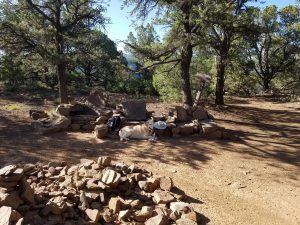Around a half-century ago, unknown persons built two stone chairs at the summit of Devisadero Peak. The chairs on this 2500-meter foothill east of Taos, New Mexico were a favored destination for resident hikers and visitors. They became part of the natural and historic landscape. Huddled together, on each, seat height above the ground was not far. Single rock slabs formed high backs, tipped at a slight angle from vertical. (More recently a few more rocks were piled up beside the chairs.)
The homemade land art were old friends providing a degree of comfort and sense of reward for those having achieved the summit. In their destruction this past spring, they became martyrs of conscious loss: the policy to diminish, extirpate, or eliminate something.
When this policy is implemented by the destruction of just one thing at a time, this form of loss becomes an example of gradual diminishment. Pointless dismantling of larger scale things—species, ecosystems, democracies—operates on the same principle at the small scale of rustic furniture. At any scale, gradual diminishment results in a loss of meaning.
For unknown reasons, this past spring, the management of Carson National Forest felt that dismantling the chairs was an important use of scarce taxpayer money. The rocky remains of the corpse chairs were scattered across what little un-trampled native vegetation remained at the summit. A Carson Forest official assured me that the chairs were not “significant.”
Not significant to whom?
Increasingly, our natural and historical heritage is seen as not significant. An endangered species here, a riparian area there, a modest structure on a minor mountain, all can disappear and what does it matter? As things (and creatures) of beauty disappear no more than one at a time we hardly notice. As one lovely thing or place is removed from our national lands, we can make the case that the loss of that particular one thing is not important.
The insidiousness of gradual diminishment arises from its pace (slow, local) and its placement (separated localities). It becomes conscious loss when it is the result of intended policies. It is a loss of meaning, in this case, the loss of a relationship of a particular structure to the land, and of the structure in the perception of its visitors as a naturalized monument that for many defined a particular place.
Gradual diminishment demonstrates a tangled and awful mindset that allows, one by one, much that is valuable to be officially vandalized, or neglected, or to disappear altogether. Added up, the loss of one thing at a time eventually becomes tragic. What happened? Where did it all go? Why didn’t we say something when each of us noticed that one thing that was important, even if, as in the case of the stone chairs, it was a small thing?
Generally True Pattern: We and everything are connected.

